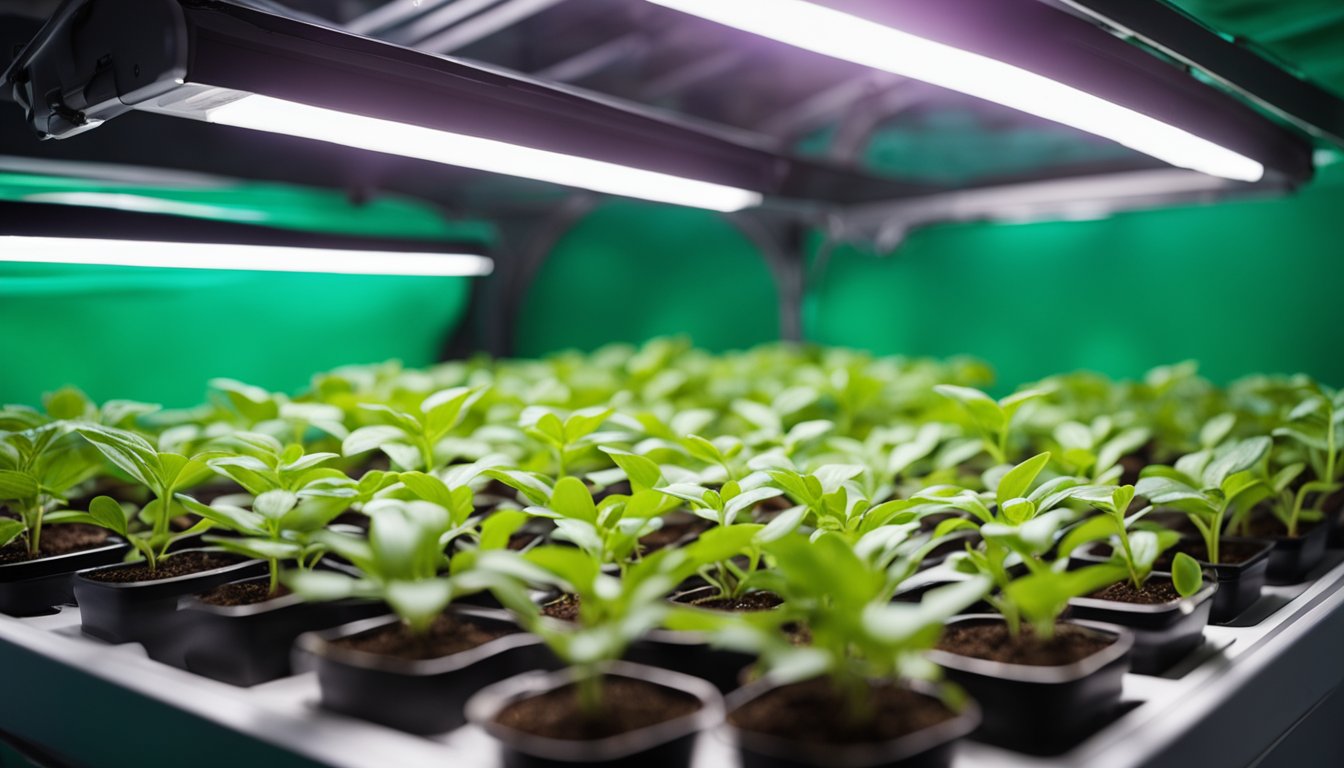Growing plants indoors can be incredibly rewarding, but understanding light cycles in grow kits is the key to success. I’ve seen firsthand how the right light exposure can transform a struggling seedling into a flourishing plant. It’s not just about keeping your grow lights on; it’s about mastering the timing and intensity to mimic natural sunlight.
Understanding Light Cycles in Grow Kits
Light cycles play a vital role in the health of my indoor plants. To thrive, plants require specific light durations and intensities. I aim for a balance that mimics natural sunlight.
I keep the light on for about 14 to 16 hours during the day. This duration supports most growing stages, from seedlings to mature plants. At night, I turn off the light for 8 to 10 hours to allow for rest. Just like me, plants need their beauty sleep.
Different plants have varying light needs. For example, leafy greens enjoy plenty of light, while some herbs prefer slightly less. I check the plant type before deciding on the best cycle. Proper research pays off.
Intensity also plays a key role. I adjust the distance of my grow lights to provide adequate coverage. For instance, if the lights are too far away, plants may stretch too much, looking for light. This stretch may lead to weak stems.
Another factor is the light spectrum. I use a combination of red and blue light to support growth. Blue light encourages strong, healthy leaves, while red light promotes flowering. Mixing these two can create a vibrant ecosystem.
Remember, timing isn’t everything. Consistency matters too. I always try to keep the light schedule regular. Sudden changes can confuse plants, causing stress. My plants thrive with routine.
Importance of Light Cycles
Light cycles are essential for healthy plant growth in growing kits. Understanding how these cycles work leads to robust seedlings and flourishing plants.
Impact on Plant Growth – Understanding Light Cycles in Grow Kits
Light affects how plants grow and thrive. Plants convert light into energy through photosynthesis. Duration of light exposure influences growth rates, leaf size, and overall plant strength. For example, too little light can cause stunted growth, while too much may burn the leaves. I aim for 14 to 16 hours of light during the day. This balance allows plants to maximize growth potential without overdoing it. Ever notice how a plant leans towards light? It wants to soak up every bit it can get!
Types of Light Cycles – Understanding Light Cycles in Grow Kits

Understanding light cycles can transform your growing experience. Different light cycles serve various plant needs, so choosing the right type matters.
Continuous Light
Continuous light keeps grow lights on for extended periods. Some plants love this approach. Indoors, I often use continuous light for seedlings that crave more sun. This cycle typically runs for 18 to 24 hours daily. The extra light can boost growth in young plants, but this method needs careful monitoring. Leaving lights on for too long may stress plants or lead to excessive heat. So, I check temperature levels frequently to keep the environment cosy and safe.
Intermittent Light – Understanding Light Cycles in Grow Kits
Intermittent light combines on and off periods. This cycle mimics natural sunlight better than continuous light. I find that many larger plants benefit from this setup. Usually, I set the lights to be on for 12 to 16 hours and off for 8 to 12 hours. During the off time, plants get to rest, store energy, and process what they absorb. This cycle promotes healthier growth patterns. Quirky bonus: during their downtime, plants don’t just sit there; they go about their photosynthesis business, even if no one’s watching.
Implementing Light Cycles in Grow Kits
Setting the right light cycles in grow kits boosts plant growth and health. Knowing when to turn lights on and off helps create an environment similar to nature.
Recommended Schedules
I suggest using a light schedule that suits the specific plants. Most plants thrive with 14 to 16 hours of light each day. This duration simulates natural sunlight effectively. For seedlings, I recommend a longer cycle, around 18 hours of light. It encourages growth without overwhelming them.
For flowering plants, I often use a setup of 12 hours on and 12 hours off. This mimics seasonal changes and supports blooming. Remember to adjust as plants mature. Observe their response to the light schedule. If they seem stressed, changing duration and intensity can help.
Common Mistakes to Avoid – Understanding Light Cycles in Grow Kits
Many people overlook consistent light schedules. Plants appreciate routine, so changing times randomly can lead to stress. I’ve seen plants struggle when their light cycles fluctuate too much. Stick to the plan, and your plants will be happier.
Another common pitfall includes using only one type of light. Not all plants respond well to single-spectrum light. Combining red and blue wavelengths encourages balanced growth. Additionally, avoid keeping the lights too close to the plants. This can cause leaf burn. A little space goes a long way.
Understanding how light cycles work leads to great success in growing plants. Adjust schedules based on what plants tell you. They can be quite vocal about their needs with a few signs.
Tools for Monitoring Light Cycles

Monitoring light cycles is essential for plant health. Several tools help me keep track of light schedules, ensuring my plants get what they need.
Timers and Controllers
Timers ease the process of managing light cycles. I set them to turn lights on and off at specific times. It’s like having a personal assistant for my grow room. Digital timers allow for precise scheduling and multiple light settings. I often use programmable timers that even let me change schedules easily. Smart controllers add another layer of convenience.
They connect to my smartphone, allowing me to adjust settings remotely. I can check if my lights are on, even when I’m out. These options provide peace of mind, knowing my plants get consistent light.
Light Meters – Understanding Light Cycles in Grow Kits
Light meters measure the intensity of light. I use them to ensure my plants receive the right amount of light for growth. These devices can help identify hot spots and shaded areas in my growing space. Each plant has unique light needs.
The meter allows me to optimize conditions for all my greenery. It’s simple: if the meter reads low, I know I need to adjust the lights. If the reading is too high, I can reposition them to prevent leaf burn. Using a light meter gives me the confidence that my plants are thriving under the right conditions. Plus, it beats guessing how much light my plants get.
Before You Go – Understanding Light Cycles in Grow Kits
Mastering light cycles is key to successful indoor gardening. By understanding the specific light requirements of your plants and maintaining a consistent schedule, you can create an environment that promotes healthy growth.
I’ve found that using timers and light meters not only simplifies the process but also ensures that my plants receive the right intensity and duration of light. Observing how my plants respond to different light conditions has been invaluable in fine-tuning my approach.
With the right light cycle in place, you’ll be well on your way to transforming your grow kit into a thriving garden. Happy growing! Don’t forget to add The Herb Prof to your favorites so you don’t miss out on future articles.
References – Understanding Light Cycles in Grow Kits
Little Herb Encyclopedia, by Jack Ritchason; N.D., Woodland Publishing Incorporated, 1995
The Ultimate Healing System, Course Manual, Copyright 1985, Don Lepore
Planetary Herbology, Michael Tierra, C.A., N.D., Lotus Press, 1988
Handbook of Medicinal Herbs, by James A. Duke, Pub. CRP Second Edition 2007
The Complete Medicinal Herbal, by Penelope Ody, Published by Dorling Kindersley
Check the Following Articles
10 Best Seeds to Start Growing in January
Ashwagandha Supplements: Top 3 Rated Brands
Zarbee’s Elderberry Gummy Daily Immune Support Review
A Beginner’s Guide to Horticulture Propagation Techniques
Frequently Asked Questions – Understanding Light Cycles in Grow Kits
1. Why is understanding light cycles important for indoor plants?
Understanding light cycles is crucial because the right light exposure promotes healthy growth and helps prevent issues like stunted growth or leaf burn. Proper timing and intensity replicate natural light, essential for photosynthesis and overall plant vitality.
2. How many hours of light do indoor plants typically need?
Most indoor plants require about 14 to 16 hours of light daily. Seedlings often benefit from 18 hours, while flowering plants usually thrive on a 12-hour light and 12-hour dark cycle, mimicking natural seasonal changes.
3. What are the effects of insufficient light on plants?
Insufficient light can lead to stunted growth, smaller leaves, and weakened plants. When plants don’t receive enough light, their energy production via photosynthesis slows down, impacting overall health and vigor.
4. How does light intensity affect plant growth?
Light intensity influences growth rates and leaf development. Too little light can hinder growth, while excessive light may burn leaves. It’s essential to find the right balance for optimal plant health.
5. What tools can help monitor light cycles?
Tools like timers and light meters are highly beneficial. Timers help automate light schedules, while light meters measure intensity, ensuring plants receive the right amount of light and identifying any potential problem areas in your setup.
6. Can plants still photosynthesize in the dark?
Yes, plants continue some processes related to photosynthesis during dark periods. Although they primarily convert light to energy when illuminated, they can still utilize energy stored during previous light exposure.
7. How should I adjust light schedules for different plants?
Different plants have unique light requirements. Research the specific needs of your plants and tailor light cycles accordingly, generally, 14 to 16 hours for most plants, while seedlings and flowering plants have different specific needs.
8. What common mistakes should I avoid with light cycles?
Avoid inconsistent light schedules and relying solely on one spectrum of light. These mistakes can stress plants and hinder their growth. It’s vital to maintain a steady schedule and use a balanced light spectrum for optimal health.

